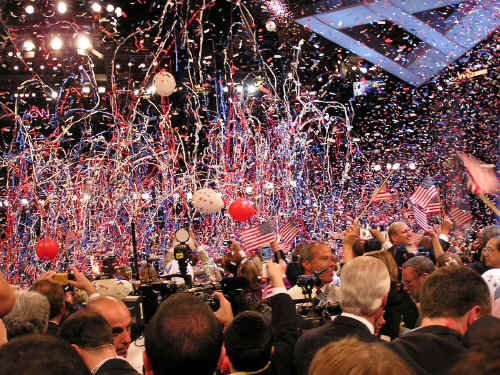
Every four years, Republicans and Democrats hold political conventions to nominate candidates for president and vice president. In recent years, the reporters and pundits who cover the conventions are quick to argue that the party gatherings are irrelevant. But are they?
With the exception of one hour at 10 p.m. Eastern Standard Time, the television networks all but ignored the recent conventions this year. Though television coverage was limited, each network—well aware that viewership is much greater than the media executives would like to admit—sent a bevy of reporters, television crews, and the usual talking heads to each convention. Committing only one hour was more about not taking too much time away from lucrative prime time advertising.
There were pundits who lamented how unfortunate it was for the Democrats that President Clinton’s speech Wednesday night coincided with the N.F.L. season opener. The football game had some impact on the viewers, but according to the Nielson ratings, more people tuned in to watch the former president’s speech than tuned in to watch the New York Giants-Dallas Cowboys game.
To a lesser extent, Ann Romney, the wife of Republican presidential nominee Mitt Romney, also attracted a large audience at the Republican Nominating Convention. Michelle Obama attracted 26.2 million, while Ann Romney drew 22.3 million viewers. Those numbers are not bad by any Nielson standards.
It is true that the historic combativeness of past political conventions with floor fights, favorite son candidates, brass bands hoopla, and the backroom wheeling and dealing are gone forever. They were great fun and the few television channels before cable devoted the entire day to the sometimes crazy and always colorful events taking place in the convention halls. The circus had come to town and it was irresistible. It was democracy in the rawest, best form.
The “political reforms” that took the nominating process out of the smoked filled rooms, did take the excitement out of conventions where something was actually accomplished and argued over: the party platform and the candidates who would be assigned to represent the respective parties. No one was ever certain who would win the roll call of the states, and there were conventions that went on for days with exhausting vote after vote before a candidate was selected.
There was not much real business at the recent conventions: the two parties confirmed who the party standard bearers would be (big surprise there) and platform planks were generally hammered into place before being offered pro forma to the delegates.
While there might not have been a lot of decision making, these two recent conventions were important and represent a significant part of the democratic process. If nothing else, the conventions expose the vast electorate to the differences in the two parties; this election year there are clear differences. These conventions also introduced the voters to the political stars and future stars many voters had never seen or often never heard of. A not widely known President Obama, for example, first was noticed when he gave the Keynote Address in 2004 and it was quickly seen that he had a great political future. Years earlier, a similar thing happened to then Arkansas Gov. Bill Clinton.
If you hadn’t watched the Republican and Democratic conventions, you would have missed the remarkable speech of First Lady Michelle Obama and the effective address of Ann Romney. Both women set out to humanize their husbands and both succeeded. The view came away with a better understanding of the two men.
The Republicans had the opportunity to introduce their vice presidential candidate Paul Ryan, who wasn’t widely known, and the Democrats fielded a number of young candidates with a future. What was obvious at both conventions was that the party faithful—and the conventions exist for the party faithful—left excited and energized. Parties need to have that strengthening of support for the chosen candidate so they can get out the vote.
Although it is argued that most people have known who they plan to vote for in November, the conventions still introduce new people to the political process. There may have been a 15-year-old boy or girl watching for the first time who became inspired to get involved in the political process and might run for office one day.
Presidential nominating conventions may not be as exciting as they once were, but they are still significant and relevant.


Be the first to comment